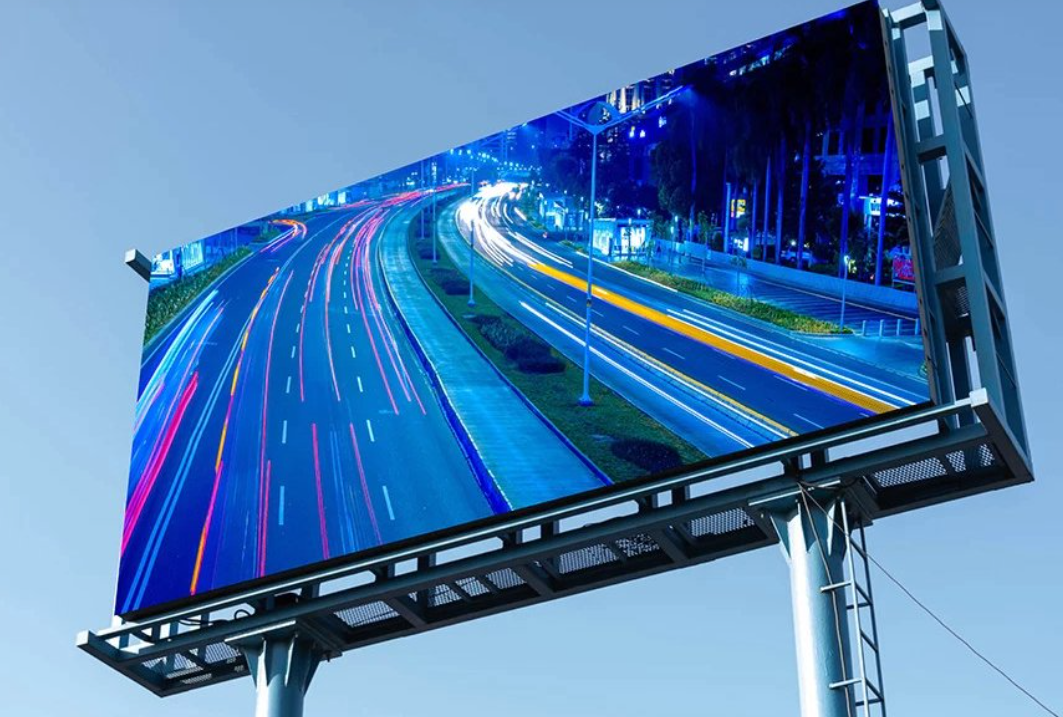In the digital era, LED displays, are key in diverse applications. This article centers on dispensing machine inkjetting: exploring how it solves display – development challenges, shapes uniform light – emitting layers, synergizes with SMT equipment, and impacts COB/SMD packaging contrasts. It also recommends top inkjetting tools, highlighting its role in LED display innovation.
Sommario
AlternaThe Basics of LED Display Operation
LED Chip Luminescence Principle
LED, short for Light Emitting Diode, features a semiconductor chip, commonly made from compounds of gallium (Ga) with arsenic (As), phosphorus (P), etc. When a forward voltage is applied, electrons and holes recombine within the chip, emitting visible light. Different semiconductor materials yield various colors; for example, gallium arsenide phosphide emits red light, while gallium phosphide produces green light.
Pixel Composition and Image Display
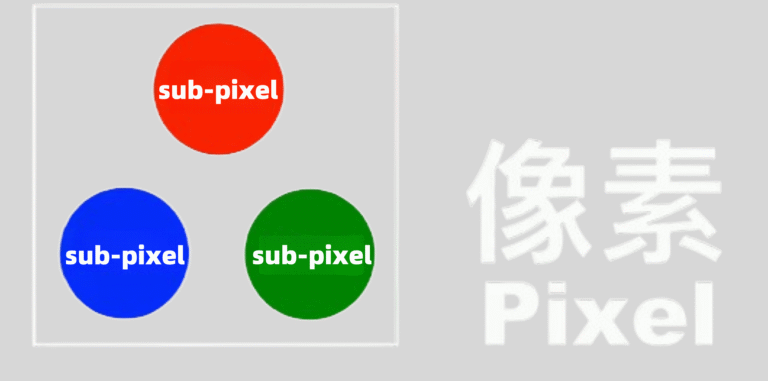
An LED display comprises numerous tiny pixels, each containing red (R), green (G), and blue (B) LED chips, functioning as miniature light sources. These pixels are orderly arranged on a Printed Circuit Board (PCB), which acts as the “nervous system,” supplying power and transmitting control signals to each LED chip via intricate circuits.
During operation, the control system converts visual information (images, text, videos) into digital signals, which travel through the PCB to the corresponding driver chips of each pixel. These driver chips precisely regulate the brightness and activation duration of the R, G, and B chips. By combining these three primary colors at varying intensities—such as mixing red and green to create yellow—thousands of colors are generated. Coordinated pixel operation results in clear, vibrant images.
The Journey of LED: SMT Equipment Fuels Industrial Growth
Early Exploration and Inception of LEDs
In the early 20th century, scientists delved into the optoelectronic properties of semiconductors. In 1962, Nick Holonyak Jr. from General Electric invented the first practical visible – light LED—a red – emitting diode. With low brightness and limited color options, it marked the dawn of a new era in lighting and display. Initial LED manufacturing, relying on manual or semi – automated methods to attach chips to substrates, was inefficient and inconsistent in quality.
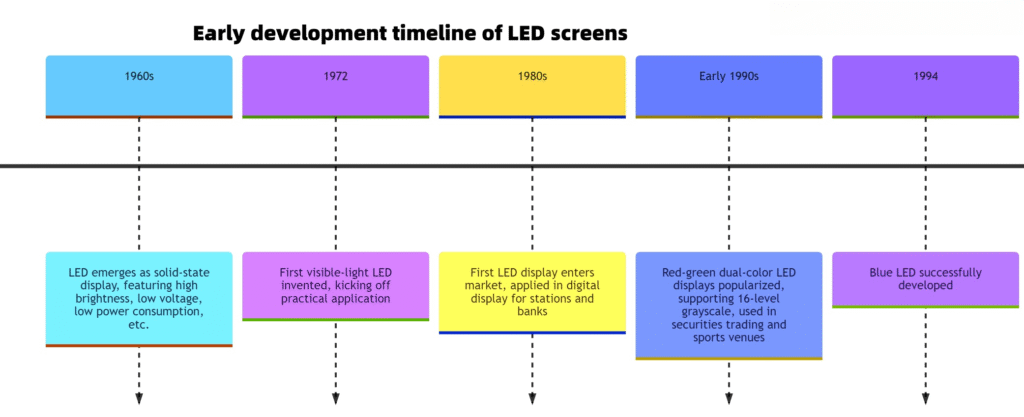
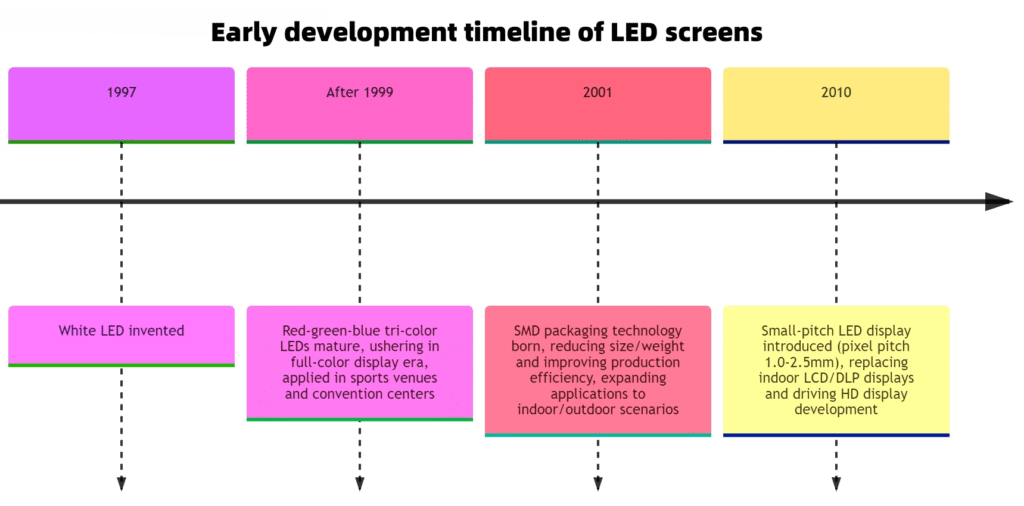
SMT Equipment Drives Large - scale LED Production
As technology advanced and demand grew, traditional production methods could no longer meet industrial needs. Surface Mount Technology (SMT) emerged, enabling precise placement of tiny LED chips onto PCBs, significantly enhancing production efficiency and product quality. In an SMT production line, solder paste is first evenly printed onto the PCB pads using a screen printer. Then, a high – precision pick – and – place machine, equipped with advanced visual recognition systems, accurately positions the LED chips on the paste – coated pads with micron – level precision. Finally, a reflow oven melts the solder paste, establishing electrical and mechanical connections between the chips and the PCB. This automated process revolutionized LED production, reducing costs and facilitating widespread adoption in lighting and display applications.
Collaborative Innovation between LED Displays and SMT Technology
With the continuous evolution of LED technology, LED displays have become mainstream. The demand for smaller pixel pitches and higher – resolution displays has spurred innovation in SMT equipment. For instance, new pick – and – place machines for Micro LED chips (measuring just tens of microns) utilize advanced Micro – Electro – Mechanical Systems (MEMS) technology and precise motion control algorithms to achieve high – speed, accurate chip placement. Additionally, AI – powered image recognition has enhanced in – line quality inspection, enabling real – time detection and correction of issues like chip misalignment or cold soldering, ensuring high – yield production of LED displays.
COB vs. SMD Packaging: Principles, Differences, and Impacts
SMD Packaging Technology
SMD (Surface Mounted Devices) packaging involves pre – encapsulating LED chips into individual small beads (e.g., integrating red, green, and blue chips in a plastic bracket) before soldering them onto a PCB using SMT. Each LED bead is independently encapsulated, forming separate light – emitting units fixed to the PCB via soldered joints, leaving exposed pads.
Advantages:
- High resolution, supporting small pixel pitches (up to 1.2mm), ideal for high – definition displays.
- Mature technology with a well – established supply chain, lower costs, and easy maintenance (individual faulty beads can be replaced).
- High brightness, suitable for indoor and outdoor applications like billboards and stage backdrops.
Disadvantages:
- Lower stability; soldered joints are vulnerable to external forces, moisture, and dust, potentially causing dead pixels.
- Poor heat dissipation as the independent bead design may trap heat at the joints.
- Visible pixel gaps at close range, especially in displays with larger pitches.
Typical Applications:
Common LED displays (indoor/outdoor billboards, video walls), backlighting for consumer electronics (e.g., TVs).
COB Packaging Technology
COB (Chip on Board) directly integrates multiple LED chips (red, green, blue) onto the PCB substrate, followed by encapsulation with fluorescent glue and protective materials, creating a seamless light – emitting surface. Without individual bead structures, COB features direct chip bonding to the substrate, with the entire panel covered by protective materials like silicone.
Advantages:
- High reliability; no exposed joints, offering excellent dust, moisture, and impact resistance, suitable for harsh environments.
- Superior heat dissipation as chips are in direct contact with the substrate, facilitating rapid heat transfer.
- Uniform display with a continuous light – emitting surface, eliminating pixel gaps and providing a smooth viewing experience, especially for small – pitch displays.
- Long lifespan with low dead – pixel rates and reduced maintenance costs.
- Capability to achieve extremely small pixel pitches (e.g., 0.9mm, 0.7mm, 0.43mm).
Disadvantages:
- Difficult to repair; replacing the entire module is often required for faults, increasing costs.
- Higher initial investment due to complex processes and less mature industrial infrastructure compared to SMD.
- Limited brightness as encapsulation materials may affect light efficiency, requiring optimization for high – brightness scenarios.
Typical Applications:
High – end indoor displays (conference rooms, command centers), industrial applications (medical, security monitoring), and cutting – edge Mini/Micro LED technologies.
Selection Guide:
- Choose SMD for budget – conscious projects, high – brightness requirements, or easy – maintenance scenarios (e.g., outdoor advertising).
- Opt for COB when prioritizing high stability, long – term reliability, and small – pitch displays (e.g., conference rooms, monitoring centers).
Challenges in LED Display Development: Color Aberration in Small - Pitch Displays
Color Aberration in Small - and Ultra - Small - Pitch Displays
As visual quality demands rise, small – pitch (pixel pitch ≤2mm) and ultra – small – pitch (≤0.9mm) LED displays are gaining popularity for their high – resolution visuals. However, they face a significant issue: color aberration.
Root Causes of Color Aberration
- Inconsistency of LED Beads: Even within the same production batch, LED beads vary in brightness and color wavelength due to manufacturing limitations. In small – pitch displays, these minor differences are magnified, resulting in inconsistent colors and brightness between adjacent pixels. Both COB and SMD are affected; COB’s integrated design may concentrate the impact within a module, while SMD’s independent beads can scatter the effect across the screen.
- Limitations of Traditional Mask Processes: Early LED displays used black masks on PCBs to block light gaps and enhance contrast. For small – and ultra – small – pitch displays, traditional mask manufacturing struggles to meet precision requirements. Creating fine structures for tiny pixel pitches and ensuring accurate alignment with beads are challenging, leading to poor light shielding, increased light scattering, and exacerbated color differences. COB’s integrated nature makes traditional masks less adaptable, while SMD, though more adjustable, still faces precision challenges at small pitches.
- Heat Dissipation and Drive Circuit Effects: High bead density in small – pitch displays causes concentrated heat. Inadequate heat dissipation leads to color shifts as different areas of the display heat up unevenly. Variations in drive circuits can also result in inconsistent drive currents, affecting bead brightness and color. COB, with chips directly attached to the PCB, has a shorter theoretical heat – dissipation path but requires sophisticated PCB heat – dissipation designs. SMD, with beads connected via brackets, has a more complex heat – dissipation route, and both methods demand careful optimization to mitigate color aberration.
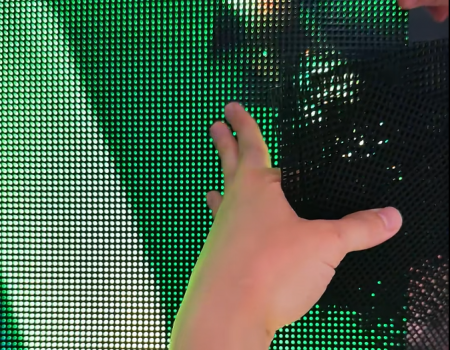
Manual background mask insertion
Dispensing Machine Injetting Technology for Mitigating Color Aberration in LED Displays
Principio di funzionamento
Precision spraying of black or colored inks onto the PCB of LED displays or between pixel units. For COB modules, graphic inkjetting via printing technology forms virtual masks between pixels, significantly reducing color difference between modules and enhancing display contrast.
Soluzioni
1. Background Masking
Function: Covers the PCB’s base color, which often causes inconsistent color tones in large screens.
Implementation: Specialized inks are sprayed onto the PCB using dispensing/inkjet equipment to ensure uniform ink color, minimizing color deviations caused by the PCB’s base color affecting LED emission.
2. Integrated Mask Formation
Function: Creates an integrated mask between pixel units of LED displays, especially for COB packages.
Effect: Addresses seam gaps and color differences between COB modules, prevents light crosstalk between pixels, and achieves uniform color consistency across the display.
Technical Notes
UV-curable inks with high light absorption (≥99.5% at 450-700nm) are typically used to optimize contrast and color uniformity.
Equipment Recommendations

Click the link to learn more about the Equipment:High – speed Precision Dispensing Machine D450S: Core Equipment for Solving Color Difference in LED Displays
Dispensing Inkjetting in LED Manufacturing
In LED display development, key challenges include ultra-narrow pixel pitches (e.g., P1.2/P0.9), precise multi-layer coating, E complex curved surface adaptation:
- Ultra-narrow Pitch Challenge: Dispensing inkjet technology addresses “uneven glue distribution and short-circuit risks” between closely spaced LED chips through micron-level droplet control (10-50μm droplets). For COB packaging, precise inkjetting prevents glue overflow onto electrodes, enhancing lighting consistency.
- Multi-layer Coating: For OLED/mini LED structures (emissive layers, dielectric layers), inkjet technology enables multi-material, multi-thickness stacking (e.g., emissive ink first, then dielectric isolation), eliminating “thickness variations and interlayer color mixing” issues from traditional blade coating, ensuring color purity.
- Curved Surface Adaptation: For flexible/irregular displays, non-contact inkjetting adapts to surface height differences, replacing traditional needle dispensing prone to “scratching and leakage,” expanding design possibilities (e.g., automotive curved screens, wearables).
The uniformity of light-emitting layers directly impacts display brightness consistency. Dispensing inkjet technology achieves breakthroughs via precise ink control + intelligent processes:
- Ink Dispersion Control: Utilizing piezoelectric valves for precise ink delivery (repeat positioning accuracy ±0.02mm), ensures consistent droplet volume and placement of emissive materials (e.g., phosphor glue, quantum dot ink), eliminating “bright/dark spots” caused by uneven distribution.
- Drying and Curing Synergy: Post-inkjetting, zonal temperature-controlled annealing (e.g., 80°C pre-bake + 120°C full cure) resolves “shrinkage and light-emission shift” issues from uneven drying, ensuring microstructural uniformity for stable brightness.
- Edge-to-Center Consistency: Vision-guided positioning dynamically adjusts inkjet parameters (e.g., increased edge ink volume to compensate for substrate reflection), ensuring uniform thickness and material concentration across the screen, eliminating “center-bright, edge-dark” effects.
SMT lines aim for seamless automation in “placement-dispensing-soldering-inspection.” Dispensing inkjet technology contributes through:
- Timing and Precision Synchronization: Inkjet systems integrate with pick-and-place machines via PLC communication, initiating glue dispensing along pre-programmed paths (e.g., PCB pad reinforcement) within ±20μm accuracy after component placement, minimizing human error-induced misalignment.
- Data Interconnectivity and Traceability: Inkjet parameters (volume, position, speed) integrate with SMT data (component info, soldering profiles), forming a complete data chain. For defective batches, 追溯 inkjet volume anomalies enables rapid root cause analysis.
- Flexible Production Adaptation: Support for quick product changeovers (software-driven program switching) collaborates with SMT feeder systems to transition between large-format and narrow-pitch displays in <10 minutes, optimizing multi-variety, small-batch production.

